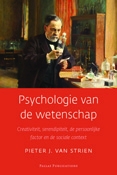Creativiteit en serendipiteit in de wetenschap

Bij Amsterdam University Press verschijnt volgende week het boek Psychologie van de wetenschap. Creativiteit, serendipiteit, de persoonlijke factor en de sociale context. De auteur is Pieter J. van Strien, emeritus hoogleraar psychologie bij de RUG. Het werk is het enige up-to-date Nederlandstalige boek over creativiteitspsychologie en psychobiografie. Speciale aandacht gaat uit naar de persoonlijke bronnen van creativiteit en de biografische wortels daarvan.
Het boek is om te beginnen verrassend omdat creativiteit niet alleen wordt geanalyseerd en aan de hand van voorbeelden geïllustreerd, maar ook gerelativeerd. De magie van ‘ondoorgrondelijke genialiteit’ wordt ingeruild voor de realiteit van nuchter denkwerk en het inspelen op toevalsmomenten. En zo zijn er meer relativeringen die ingaan tegen het gangbare beeld van creativiteit. Het boek verrast ook door de verbanden die worden gelegd met wetenschapsfilosofische en –sociologische beschouwingswijzen. Daarbij wordt voortdurend verwezen naar historische ontdekkingen. Onderlinge rivaliteit en ‘schijncreativiteit’ (fraude, plagiaat) komen in een nieuw licht te staan.
Grote ontdekkingen
Als achtergrond geeft Van Strien een breed overzicht van het recente onderzoek naar en de theorievorming over creativiteit in het algemeen. Ook grote historische vondsten blijken vaak de bekroning van geduldig volgehouden nuchtere arbeid, zelfs wanneer de creatieve oplossing zich plotseling in een flits aan de geest lijkt te presenteren. Toevallige vondsten (serendipiteit) vallen alleen ten deel aan ‘goed voorbereide geesten’, een duidelijke relativering van de mythe van ondoorgrondelijke creatieve genialiteit. Een andere relativering is dat veel fundamentele historische ontdekkingen gerepliceerd kunnen worden met behulp van een vrij simpel computerprogramma. Naar aanleiding daarvan gaat de auteur uitvoerig in op het ‘menselijk surplus’ boven creativiteit per computer.
‘Revolutionaire’ doorbraken
‘Revolutionaire’ doorbraken zijn eerder de laatste stap in een geleidelijke over generaties heen lopende denkontwikkeling, dan de visie van enkelingen. Dat geldt bijvoorbeeld voor de Copernicaanse omwenteling en het in de zeventiende eeuw opkomende mechanische wereldbeeld. Daarmee relativeert het boek opnieuw de mythe van het in eenzaamheid scheppende genie. Hetzelfde geldt voor de befaamde ‘paradigmawisselingen’ van de wetenschapsfilosoof Thomas Kuhn.
Rivaliteit, fraude en plagiaat
Ook wetenschapssociologische bevindingen komen in een nieuw licht te staan. Zo blijkt dat ontdekkingen vaak vrijwel gelijktijdig door verschillende onderzoekers worden gedaan (‘multipels’). De resulterende rivaliteit en strijd om erkenning maken het begrijpelijk dat sommigen hun toevlucht nemen tot fraude of plagiaat om de schijn van creativiteit te wekken. Van Strien illustreert dit met tal van voorbeelden.
Psychobiografie
Behalve de historische en de sociale context komt de persoonlijke factor uitgebreid aan bod: de kenmerken van de creatieve persoon en mogelijk biografisch significante levenservaringen, waardoor creatieve ideeën tot leven kunnen zijn gewekt. Zo wordt verband gelegd tussen leven en werk van kopstukken op het gebied van de natuurwetenschappen (Newton, Faraday, Bohr, Heisenberg), de psychologie (William James) en de sociologie (Max Weber). Van Strien besteedt daarbij ruimschoots aandacht aan de tijdens de afgelopen decennia steeds prominenter geworden psychobiografie. De eenzijdig Freudiaanse denktrant die daarbij tot voor kort overheerste blijft echter achterwege.
Curriculum vitae
Pieter van Strien (1928) is emeritus hoogleraar psychologie met een nevenbenoeming aan de Faculteit Wijsbegeerte aan de RUG. Hij heeft tal van publicaties op uiteenlopende onderdelen van zijn vak op zijn naam staan. Het vraagstuk creativiteit houdt hem al gedurende zijn hele loopbaan bezig. Nu andere verplichtingen zijn weggevallen vond hij de tijd om de oogst van zijn denkwerk binnen te halen en in boekvorm op een ook voor geïnteresseerde leken toegankelijke manier te presenteren.
Noot voor de pers
Het boek wordt woensdag 6 april gepresenteerd in de Universiteitsbibliotheek van de Rijksuniversiteit Groningen, Broerstraat 4, van 16.00-17.00 uur. Aanmelden via marketing aup.nl
Meer informatie over het boek: Amsterdam University Press: www.aup.nl
Meer nieuws
-
08 december 2025
Burgerparticipatie onmisbaar voor een duurzame energietoekomst
-
23 oktober 2025
Negen wetenschappers van de RUG ontvangen Vidi-beurs
